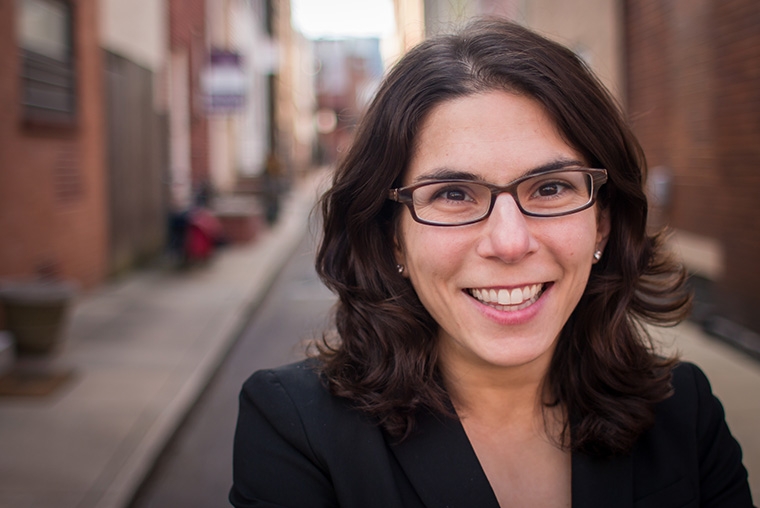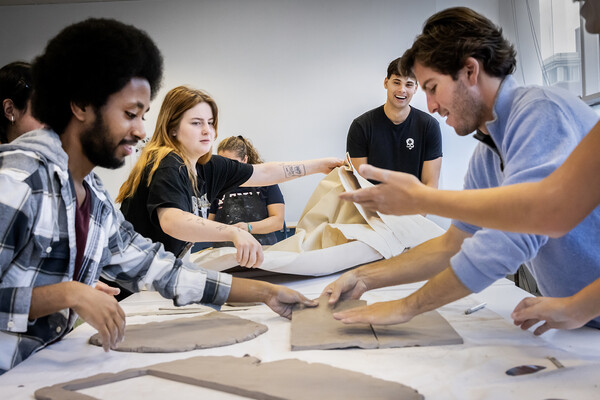
Long lines at the check-in counters, frustrated passengers stranded at airports, and the chaotic cancellation of flights due to unexpected storms or technical outages are becoming increasingly commonplace as more and more people rely on air travel, placing significant burden on decades-old infrastructure and protocols.
Responding to these growing challenges, Megan Ryerson, UPS Chair of Transportation at the University of Pennsylvania’s Weitzman School of Design and professor of city and regional planning and electrical and systems engineering at the School of Engineering and Applied Science, is part of a transformative research initiative aimed at bolstering the resilience of air travel. Funded by NASA, this project, led by a team of researchers and industry practitioners, will explore how the National Airspace System can be more adaptive to major storms, facility outages, and other technical issues that disrupt airline flight.
The project focuses on three critical thrusts aimed at transforming the National Airspace System: scenario generation; decision-making optimization; and validation, evaluation, and translation.
Scenario generation involves creating realistic simulations of potential issues such as weather disruptions and traffic congestions, allowing for proactive planning and robust contingency strategies.
The decision-making optimization portion uses advanced predictive models and operational research to provide recommendations for air traffic managers, ensuring that responses to any given scenario are effective and efficient.
And finally, the validation, evaluation, and translation focus ensures the practical application of research outcomes. It involves testing the proposed solutions in simulated environments and real-world settings to evaluate their impact and effectiveness, followed by formulating guidelines that can be implemented by stakeholders such as airport authorities, port authorities, the Federal Aviation Administration (FAA), and airlines.
The project, slated to begin in August, ironically came about during a discussion spurred by a major delay.
Turbulence at the TRB
Last year, on a chilly early January morning in Washington, D.C., Ryerson was attending the annual Transportation Research Board (TRB) conference.
Attendance ranges well into the thousands, Ryerson says, and it is a great way to connect and learn about what is going on in the field. “It’s the most special conference because it's a real motley crew of who’s who in transportation; there are a lot of Department of Transportation folks, a lot of practitioners, students, and your most seasoned professors,” she says.
As the conference was winding down, “the Federal Aviation Administration experienced a significant outage in their Notice to Air Missions system (NOTAM), a critical piece of infrastructure that communicates necessary flight safety information to pilots," Ryerson says, “and, as you could imagine, passengers and airports were in disarray and flights were grounded across the nation.”
The following morning, amid the unfolding chaos, Ryerson had planned a breakfast with Dave Lovell, a professor at the University of Maryland and her longtime collaborator in air transportation optimization. As they headed to their meeting, “my phone buzzed relentlessly with updates and messages from my colleagues trapped at airports, texting me in disbelief at the extent of this disruption.”
Sitting down for breakfast at a café near the conference venue, the atmosphere was charged with a palpable sense of urgency, Ryerson says. “The catch-up session between me and Dave quickly turned into a NOTAM deep dive,” she says, “and, with our expertise in air transportation, we saw this event not as an isolated incident but as a symptom of the broader vulnerabilities within the air transportation system.”
They discussed how such disruptions were becoming more frequent and severe, exacerbated by factors like climate change and technological failures, and the conversation turned into a catalyst as the two looked into a way to bolster the resilience of air transportation. They aimed to develop strategies that could mitigate the effects of such disruptions and decided to formalize their discussions into a white paper focusing on resilience strategies and they planned to assemble a “dream team.”
This team would later include Max Li, a former student of Ryerson’s from Penn who is now an assistant professor of aerospace engineering at the University of Michigan; Patty Clark, as the former chief aviation strategic officer at the Port Authority of New York and New Jersey, with extensive experience monitoring and solving delay problems at major airports in the New York area; and Mark Hansen, a professor of civil engineering at the University of California, Berkeley, who had been Ryerson's Ph.D. advisor.
With the groundwork laid, Ryerson and her colleagues began reaching out to other potential collaborators and community colleges, involving them in crafting a full proposal to submit to NASA.
Expanded operations
By mid-2023, Ryerson and the team were ready to submit a comprehensive proposal. They targeted a specific NASA call for projects under the University Leadership Initiative and saw this as a unique opportunity to highlight the work of community colleges by including several neighboring institutions in their proposal.
“Education, outreach, and workforce development are a huge component of this project,” says Li, who will be serving as a faculty co-director in public outreach and supporting initiatives for spreading awareness of opportunities to learn more about the aerospace industry. “We’re here to highlight the broader roles that support the people we see when we hop on planes. From aircraft mechanics and engineers to airline and airport management there are programs from our partnered institutions that will help the next generation’s workforce join the bigger ecosystem here.”
Ryerson says that their work towards bolstering resilience within air transportation contributes to equity in mobility. “For many, paying that airfare is a big expense,” she says, we want to ensure “that, if the flight is cancelled because things happen, there are provisions in place to get you to your destination in a way that won’t negatively impact you or your finances.”
The nuts and bolts
Ryerson explains that the provisions she and her team seek to tie in some existing frameworks airlines use to remedy such problems, such as inter-airline agreements. “These are essentially deals that airlines may make with each other when they have to deal with stranded passenger during a disruption,” she says. “One airline will buy tickets from a competitor airline to accommodate passengers to make sure they can get stranded, disrupted passengers where they need to be.”
There are nuances, though, because companies want to make a profit, she says. “So strange things start to happen in this space. Like airline ‘X’ severing an inter-airline agreement with ‘Y,’ not selling to Y during an outage because X comes out looking a whole lot better if Y fails to deliver during a bad period.”
Ryerson also cites how airlines have years-long leases on gates at airports and that one airline may decide to block access to a gate from a competitor’s plane that needs to use it, which means “if your plane has to land at a gate that’s not permitted for use, and that’s the only one that’s open, you may just sit on the tarmac until a common-use gate opens up. Since there aren’t many common-use gates at most airports, that could be a long wait.”
Ryerson emphasizes the importance of predictive analytics and simulation-based preparedness in managing these inter-airline dynamics more effectively, and the team is taking the lessons learned to generate the next set of protocols.
Li's contributions to the proposal sheds light on the use of machine learning models to forecast air traffic scenarios and develop contingencies for each of the major stakeholders.
“For situation A, we’re going to have plan 1, plan 2, plan 3, and so on, and we’re going to make sure that these contingencies are tailored to whoever we’re talking to. For airlines, we adapt one set of models because their objectives are different than even another competitor airline. You could have different competing objectives and neither of these airlines’ objectives are necessarily aligned with that of the airport, which may not be aligned with that of the FAA. So, this is what makes the problem tricky because there are multiple stakeholders with multiple objectives, but that's what also makes it exciting from a mathematical perspective,” Li says.
“But you can make all the models you want and try predictions till you turn blue, but that means close to nothing if you don’t have a keen understanding of how situations on the ground tend to pan out, which is where Patty and her decades of experience at the airport have and continue to provide valuable insights,” Li says.
Connecting more than flights
Li and Ryerson note how Clark has helped them broaden their research beyond wheels-up to wheels-down to account for variables that often go unseen in the literature.
“Patty Clark is a brilliant leader in air transportation. Since the early days of my career, she has been teaching me about how the air transportation system truly runs and introducing all of us to parties involved from the Port Authority to get their perspectives. Patty is completely focused on passenger mobility and passenger customer service in air transportation,” Ryerson says.
“The Port Authority always took the position to make sure passengers are taken care of before and after they land, so in working with Mark, Megan, and more recently, Max, I had shared as much valuable information about the considerations staff make when things don’t go as planned,” Clark says. “If a plane is delayed, we need to assess the availability of services in and around the airport like concessions, taxis, rental cars, trains; we need to make sure there are personnel who can handle the cargo, unexpected baggage, or passengers with special needs, and so these are all considerations that may cascade if they’re not accounted for.”
Clark says she also works to keep the focus on the broader goals of air travel, citing President Harry S. Truman’s address at the grand opening of Idlewild Airport, now known as John F. Kennedy International Airport, in which he emphasized the importance of air travel in promoting international understanding and cooperation.
“He spoke about air travel not just as a means of transportation but as a gateway to peace and mutual respect among nations,” Clark says. “This vision of air travel as a bridge between cultures and communities is something that resonates deeply with our team's objectives.”
Clark explains that this historical perspective provides a framework for the team’s efforts today in improving the resilience and efficiency of air travel. “It’s not just about getting passengers from point A to point B. It’s about ensuring that air travel remains a reliable and accessible service that fosters connectivity and understanding across the globe,” she says.







